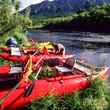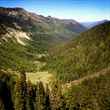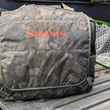For most trips into the backcountry that don’t include weather related extremes, your backpack will be your most important piece of gear. Choosing an ill fitting or poorly featured backpack, or worse, one that will fail and let you down in the field, has the potential to plague your trip. Here are some guidelines on picking the right pack for you and your trip.

How to Choose
1. Buy the right size pack.
If you’re headed into the backcountry for a one or two day trip, you don’t need an 80 liter pack that is designed to carry enough gear for a week-long excursion. Though you may hope to buy a pack that will provide you versatility for both longer and shorter trips, it is important to note that larger bags are designed to carry larger loads. They’ll bring with them greater weight and won’t be as comfortable with lighter loads when compared to bags that are designed for shorter trips. That said, there are bags that are adaptable to trips of varying length, more on that below.
If your trip is 1-2 days, you’ll likely need no larger than a 40-50 liter pack (20-30 may cut it if you are efficient). Going upwards from there, a good general rule is to add 10 liters of carrying capacity for each additional night you’ll be in the backcountry. For example, a 4 night trip would likely require a 60-70 liter bag.
2. Buy a pack that fits.
Backpacks are not one size fits all, and thinking they are can get you into trouble. It is important not only to buy a pack that is designed for your frame, but to try on a variety of packs to make sure they are comfortable. Don’t forget to make sure the pack is loaded with weight similar to what you expect to carry into the backcountry. Any reputable outdoors store should have staff that are trained to consult with you on the fit of the bag and help you load it up with stuff to simulate a packed bag.
3. Pay attention to load support/distribution and ventilation.
This article won’t go into much depth regarding frame design. There are a variety of options including internal frame design, external frame design and hybrid frame designs. By in large, external frames have been relegated to packs designed to carry very large loads (100L or more). Which design to choose should be, in our opinion, based on which provides the most comfort for your body rather than the perceived pros and cons of each design. Focus on comfort in your shoulders, across the chest and primarily the bag’s ability to place the bulk of the weight you are carrying on your hips. Also make sure the bag is highly adjustable in terms of distributing the load.
If you’re traveling during the summer, place a premium on any ventilation system a pack might provide. Most backcountry hikes are long and strenuous. There’s no reason to slog through a long hike with a sweat soaked back if such can be avoided. One of the bags we’ll detail below, the Gregory Z65, excels at providing load stability and good air flow.
4. Other features.
Backpacks come with any number of additional features, many of which are vital to some and meaningless to others (if you’re headed brook trout fishing in the Smoky Mountains, for instance, you’re likely not concerned with how you’ll attach and access your ice-axe). Here are some to consider:
Hydration: if you use a hydration pack, look for a bag with a good integration system. Look for user feedback specific to this feature to determine how well your hydration system will integrate.
Accessibility: we almost gave this a category of its own. Think ahead of time about how accessible you need your pack to be. If you’ll be stopping frequently along your route and needing to access the items in your pack, look for a pack that offers numerous access points, not a bag with top-only access.
Pockets and connection points: think about what you need to carry on the outside of your pack (items such as water bottles, carabiners, fly rods, etc) and make sure your pack provides what you need and more.
Waterproofing: few bags are water proof, but many bags offer excellent water resistance without the tradeoffs that come in terms of materials and accessibility when compared to true waterproofing. These bags may, in some cases, eliminate the need for a rain cover.

5. What else?
This isn’t a tip on how to choose your bag, but how to use it once you’ve made your selection: when planning a multi-day, backcountry fly fishing excursion -- do not over pack. Do not underestimate the importance of minimizing your load. This goes doubly for newcomers and triply for those of you who think you’re not newcomers just because you hike every now and then and you don’t mind walking a little farther down the riverbank to get away from the crowds at your local stocker.
When experienced hikers tell you that you should be targeting 25 or 30 pounds, listen. Don’t assume you can add 20 extra pounds without breaking a sweat. Otherwise, you’ll learn the hard way that you were wrong (more on that below).
Recommendations and Reviews
We tested a number of offerings from companies such as Marmot, First Ascent, Gregory, REI and more during a number of backcountry fishing and hiking excursions this past summer. Most bags offered something to suit everyone with, as stated above, personal preferences on fit and features leading to each tester’s preferences. However, a few of the bags we tested stood out from the crowd.
Eddie Bauer Alchemist 40L
First Ascent's Alchemist 40 pack doesn't look like a piece of fly fishing gear, and perhaps that's because it's not. The Alchemist 40 is a serious piece of mountaineering gear designed by folks that like to climb very tall, very cold mountains. But it's a pack that is so well constructed and thoughtfully designed that its versatility spans many endeavors. As fly fisherman, we're not able to truly appreciate the ice axe quick release feature so many climbers rave about. Perhaps atypically, our fly fishing simply doesn't include that much ice climbing. That said, the type of thinking that led to the development of this much heralded feature can be found throughout the pack's design.
The pack can be used in either 40L or 55L mode, allowing you to comfortably use the pack for shorter day hikes, or longer trips of 1-3 days. Expanding the bag is quick and easy. The pack's designers also built the pack to allow for two attachment points for the shoulder harness, intended to offer a more comfortable fit for load bearing when the pack is carrying heavier cargo. Switching the harness position is quick and easy and can be completed in a matter of seconds. Most importantly, it works as designed. We also appreciated how customizable the fit is elsewhere, even offering adjustability for different torso lengths. This came in handy with testers who ranged in torso length from 17-22 inches.
Eddie Bauer also designed this bag to be tough. Scrapes and bangs from brush and rocks won't take the toll they can on many other bags, as the Alchemist 40 has an outer layer of denier double polyurethane-coated nylon fabric in all the right places. It's 210 and 420 denier, which is designed to add protection without adding significant weight. It reminds us of one of our other favorite bags, the Patagonia Stormfront pack (designed for an altogether different purpose) in terms of it's toughness. The denier also makes the bag waterproof in the areas where the denier outer layer is, such as the bottom. This eliminated worry when setting the bag down riverside or on wet days.
Stowing 3-4 rod tubes using the bag's side compartments and compression straps was easy. While you most likely won't need to carry 3-4 rods, know you can. There's also an easily accessible top compartment for storing items you'll want quick access to, such as maps, lights, snacks and so on.
We found the bag worked best in 40L mode. That's not to say conversion is a pain or the bag doesn't deliver on expandability, it does, and impressively so. We just found the bag more comfortable with lighter loads (30 pounds and under). Unless you're an over packer, this is likely where you'll want to be for a 1-3 day backcountry excursion, anyway. However, if the need arises to carrier a bulkier or heavier load, it's comforting to know the Alchemist 40 can deliver.
During more than 8 months of testing, the Alchemist 40 became a go-to pack for several 1-2 day backcountry fly fishing trips or longer trips where there was no need to slog 45 pounds of gear around. And again, the Alchemist will do it, but in our experience the bag shined in the 25 pound load range.
Gregory Z65
The Gregory Z65 ended up being the bag of choice for most of us for the longest of this year’s fly fishing excursions, a 6 day trek into Yellowstone’s backcountry with an expected 25 miles of ground to cover on foot. Despite the fact that a poor decision to reverse the direction of a planned route coupled with a gross underestimation of the time and effort required to carry overloaded 45-50 pound packs out of Yellowstone’s Black Canyon led to the abbreviation of the second half of said trip (and thus the loss of about 10 planned miles of hiking), the Z65 was the bag most of us reached for when choosing what to strap to our backs for the most demanding and lengthy trip of the year.
Gregory has a reputation for being obsessive about fit, design and testing, and the results show in their products. Though no bag is without faults, Gregory products just work, and the Z65 is no exception. The Z65 is deceptively roomy, given that when carrying lighter loads, the Z65 shrinks down elegantly to near daypack size. Once you start to stuff it however, the Z65 balloons to comfortably hold loads that will suit most 3-5 day trips.

Access is excellent, with quick and easy access through the top as well as a front access panel that offers easy on-the-trail access to virtually the entire contents of the bag, even when fully packed. Compression is also excellent, with side, bottom and top compression straps that worked well together, instead of against, each other.
Pockets and attachment points abound, offering a multitude of options for how and where to stash your gear. Like the Eddie Bauer Alchemist pack, fly rods strap easily to the bag using the pack’s side pockets and compression straps.
One of the most well-liked features of the Z65 is its extremely effective ventilation system. Though we’ve found most ventilation systems to offer big promises while delivering little results, the Z65’s ventilation system excels. The Z65 uses Gregory’s “JetStream” suspension system, which boasts “no unnecessary points of contact on your body.” During the 90+ degree hike into Yellowstone’s Black Canyon, the airflow provided by the Z65’s suspension greatly increased the comfort and wearability of the bag.
The Z65 also features dual hydration ports and a sleeve for a hydration pack, though we’re not entirely thrilled with Gregory’s chosen location for the sleeve. The ports on either side of the Z65 are definitely convenient, and the sleeve kept a 3.0 liter reservoir cool in the summer heat. The drawback came when pumping water to refill the reservoir. Accessing the reservoir with the bag completely packed was nearly impossible without emptying half of my gear. I found that placing the reservoir at the top of the Z65, just under the top draw cord ,made everything easier though it came at the expense of a slightly more top heavy setup.
The Z65’s material construction also impressed as well. Though we expected durability and water resistance from the Alchemist 40 and other packs that we tested with denier and other waterproof fabrics and zippers, we weren’t expecting much from the Z65’s water resistant claims (water resistant nylon and water resistant zippers). That was, until several fully loaded packs rode for nearly an hour, unpitched on the hitch platform of an SUV in a steady downpour. Once unstrapped from the hitch bed, each bag shed water like a duck and revealed their contents to be bone dry.
Like the other bags we tested, the Z65 excels when packed at the lower or middle ranges of its recommended load carrying capacity. For the Z65, we found that to be around 30-35 pounds. When foolishly topping out or exceeding the Z65 ‘s recommended capacity at 45 or even 50 pounds, we found ourselves longing for more padding and better load distribution.
Used properly, we found the Z65 to be the most versatile, comfortable and convenient of all the bags we tested. Due to how easily this bag morphs from day pack into multi-day excursion pack, you may end up shedding a few bags from your closet.
Summing Up
We can’t stress enough how important it is to carefully research and choose the right bag for your trip, particularly if you’re inexperienced or are embarking on a longer excursion than you’re accustomed to. Try on and spend time with several bags. Choose a bag based almost exclusively on fit and comfort, while taking features into consideration. Eliminate foolish criteria such as brand name or aesthetic appearance from your list.
Be smart. You’ll thank yourself later.
































Comments